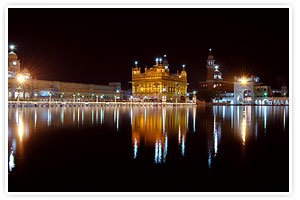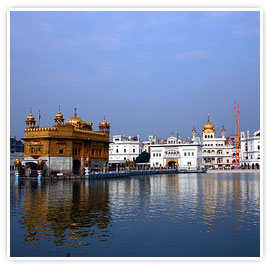Home | About Us | Privacy | Resources | Contact Us

Home | About Us | Privacy | Resources | Contact Us

Amritsar, literally meaning the 'Pool of the Nectar of Immortality', is one of the major cities of the Punjab state. The administrative headquarters of the Amritsar District, it is the major spiritual and cultural centre of Sikhs. The city, founded in 1577 by Guru Ram Das, the fourth Sikh Guru, is mostly inhabited by the Sikhs. Amritsar has grown from a sacred village pool into a spiritual centre of Sikh culture. The original pool site by which the Golden Temple is built was granted by the Mughal Emperor Akbar. In 1761 Ahmad Shah Durrani sacked the town and destroyed the temple, which was rebuilt in 1764. One of the ancient and charming cities of India, Amritsar is an important distribution centre of dry-fruits in the country. Apart from an important pilgrimage centre, the city is also famous for producing some exquiste items like carpets, fabrics, handicrafts etc.
| » Golden Temple | » Jallianwala Bagh |
| » Wagah Border | » Rambagh Garden |
| » Ram Tirath Temple | » Tarn Taran |
| » Mata Temple | » Durgiana Mandir Amritsar |
| » Gobind Garh Fort Amritsar |
 The Golden Temple wa build on 1577. A royal mandate was issued by Emperor Akbar allowing to build acity, the 4th Sikh Guru Ramdas following a request from built this city. Now to the S-West of the Amritsar Railway Station, the old city encircled with the wall with entrances. The city is now surrounded by circular road instead of wall. Alarge Sarovarorwater-reservoirwas dug up by Guru Ramdas at the heart of the city, which was started in 1573. The name Chawk Ramdaspurwas derived from his name. 5th Guru Arjan renovated the Sarovar extended the area to make it rectangular and built Harmandir in the middle of Sarovar in 1601.
The Golden Temple wa build on 1577. A royal mandate was issued by Emperor Akbar allowing to build acity, the 4th Sikh Guru Ramdas following a request from built this city. Now to the S-West of the Amritsar Railway Station, the old city encircled with the wall with entrances. The city is now surrounded by circular road instead of wall. Alarge Sarovarorwater-reservoirwas dug up by Guru Ramdas at the heart of the city, which was started in 1573. The name Chawk Ramdaspurwas derived from his name. 5th Guru Arjan renovated the Sarovar extended the area to make it rectangular and built Harmandir in the middle of Sarovar in 1601.
In the foundation laying ceremony, Guru Arjan invited Muslim Saint Hazrat Mian Mil from Lahore. The water of the Saorvar (lake) was purified to make it equivalent to Nectar (Amrita). Since then it became the Sarovar of Amrita, i.e, Amritsar. Stone-built 60 m long bridge is used as the link over the lake. In 1604, the holy scripture of the Sikh ,the hand written Sree Guru Gramh Sahib (Adi Granth Sahib) compiled by 5th Guru Arjan, was placed at Haramandir (Golden Temple). Before his death in 1708, 10th Guru Govind Singh revised Adi Granth Sahib & declared the book as the eternal Guru of the Sikhs. In 1606, Emperor Jahangir being afraid of the Sikh uprising, ordered imprisonment of Guru Arjan. And HarGobind, the son of Arjan, despite three consecutive retreats, defeated the Mughal army of Shahjahan on 4th occasion in 1629. In course of time, Amritsar became a holy place for the Sikhs. In 1757 Ahmed Sha Durani had to retreat on the face of united resistance of the Sikhs. However in 1761 Ahmed Shah Durani again invaded and captured Amritsar. He also destroyed the temple.
In 1764 the temple was rebuilt. And by 1830, Maharaja Ranjit Singh (1780-1839) built today's 3 Storeyed Golden Temple with marbles. On the entrance, the quotations from holy Granth Sahib in Gurmukhi language are inscribed. The walls set with mirrors are all ornamented with gold and colourful flower paintings. On top is a tube like dome, as if it is an inverted lotus. 3500 verses are inscribed on the dome and it 'takes 31 hours to read at a time. Maharaja Ranjit Singh wrapped the dome with 400 kg of Gold on copper base. On special days the artistic silver doors are covered with Gold-Strips. since then the name of Haramandir changed to Swarnamandir, i.e, Golden Temple. People also call it Darbara Sahib. The wall paintings are made of Hindu and Muslim architectural style and images of different animals and flowers are painted there on in Pietradira style. The whole interior of the temple is decorated with gold, silver and ivory. Apart from the main entrance, there are also four other entrance of the temple signifying that the doors of the temple are open to four Hindu Sects. At the visiting entrance Hallla-Pramd is distributed to the devotees & visitors. Dewali is the most greeted festival of Amritsar. The whole city is illuminated with lights. Tourists from far away places visit the templecity to enjoy the beauty of the lighting of the temple and fire-works. The most roaring parts of the history of Sikh religion and community and progresshave -been made alive at Clock Tower Museum at the temple-entrance. The gems and gold set canopy, presented to Maharaja Ranjit Singh by the Nizam of Hyderabad,theneck-laceof Maharaja, Chollrimade from 1120 pound of sandalwood, a peacock having an extra-ordinary artifice are all unique and preserved in the 1 st floor store-house. However this room is open to the visitors only on the birth day of Guru Ramdas.
 On 2 Oct, 1708, 10th Guru Govind Singh was stabbed at Nanded in Maharashtra, far away from Punjab by Gul Khan, deputed by Nawab of Sirhind Wazir Khan. The Guru also beheaded Gul Khan with his sword even when he was stabbed and injured. The Guru succumbed to the injury on 7 Oct. Meanwhile 4 sons of the Guru' were killed in the war with the Mughals. In order to fill up the vacant seat of Guru there was no heir; the dying Guru issued sermon to treat Sree Guru Granth Sahib containing the messages of 10 Gurus as eternal Guru. Since then, the original scripture of Sikh religion-hand-written. The Gramh Sahib is preserved like a deity in the Golden Temple. There is no rites of paying homage or worships-the GramM (reader) is reading from the Granth Sahib continuously.
On 2 Oct, 1708, 10th Guru Govind Singh was stabbed at Nanded in Maharashtra, far away from Punjab by Gul Khan, deputed by Nawab of Sirhind Wazir Khan. The Guru also beheaded Gul Khan with his sword even when he was stabbed and injured. The Guru succumbed to the injury on 7 Oct. Meanwhile 4 sons of the Guru' were killed in the war with the Mughals. In order to fill up the vacant seat of Guru there was no heir; the dying Guru issued sermon to treat Sree Guru Granth Sahib containing the messages of 10 Gurus as eternal Guru. Since then, the original scripture of Sikh religion-hand-written. The Gramh Sahib is preserved like a deity in the Golden Temple. There is no rites of paying homage or worships-the GramM (reader) is reading from the Granth Sahib continuously.
Devotees offer gifts and presents to the holy Granth Sahib as a deity. Passing the whole day in the temple at 10 pm, Granth Sahib returns to Akal Takht by being carried in procession lying in the Silver handled palanquin and covered with golden valance and decorated with gems and pearls. Next day early in the morning at 4 (5 in winter), the Granth Sahib is again taken back to the temple in procession. Visitors come to the temple to have a darshall (look) of the holy Granth Sahib.
Adjacent to Golden Temple, close to the Sarovar on top of the Golden dome is 5 storeyed Akal Takht seat of Gurus. The Takht construction was started by Guru Arjan and in 1609 Guru Hargobind (6th) completed it. The weapons used by the Gurus are condemned the genocide. The poet Rabindranath Tagore returned the' Knight hood' conferred to him in protest against the massacre. Dyer was removed and went back'to London. Around next March, under the leadership of Gandhiji, non-cooperation movement started throughout the country. Going back to London from Punjab, the then Governor 0' Dyer, while delivering a speech in Caxton Hall (at London) was killed by a Punjabi youth Udham Singh. In memory of those unknown martyrs, a beatiful red sand-stone commemoration dias has been built. The Martyrs Well is still visible in the beautiful garden. The interesting point is that on October 14, 1997 British Queen Elezabeth (2nd) during her visit to India offered flower bouquet here to show her respect to those martyrs. A Martyrs Gallery has been built with the display of the photographs and letters. In summer it is open from 9-17-00 & in winter from 10-16-00.